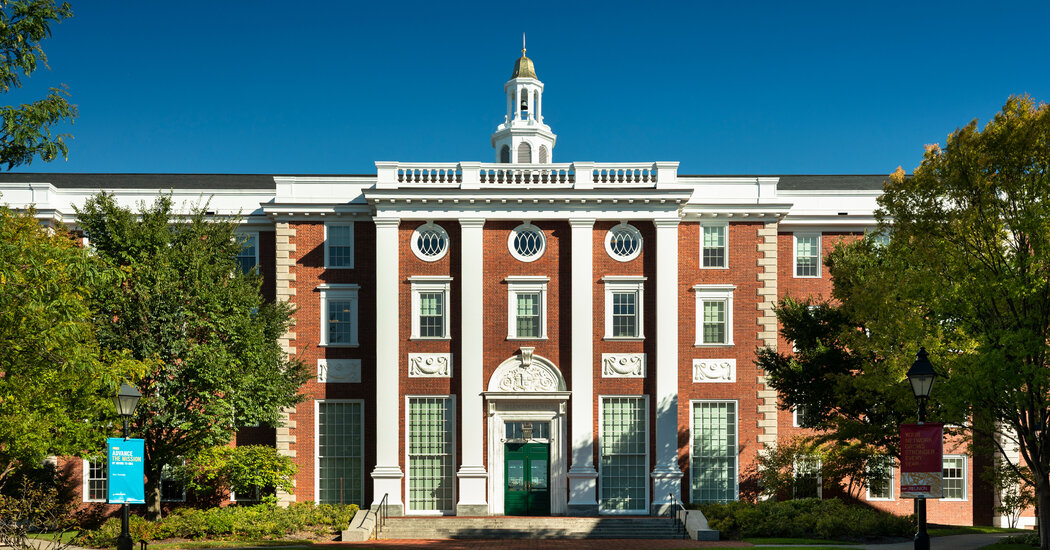NASA Is Recruiting a New Class of Astronauts
Do you dream of leaving the planet?
NASA is looking for its next group of astronauts, and you have until April 2 to make a pitch for yourself.
“Typically, it’s a very popular application,” April Jordan, NASA’s astronaut selection manager, said.
The odds that you will be chosen are slim. The last time NASA put out a call for applications, in 2020, more than 12,000 people applied.
It took the agency a year and a half to go through the applications. NASA selected just 10 of the hopefuls, or 0.083 percent. That makes Harvard’s 3.5 percent acceptance rate among high school applicants appear bountiful.
“So when I say ‘popular,’” Ms. Jordan said, “it’s probably an understatement.”
Ms. Jordan is on a media tour to spread the word that “the right stuff” for being an astronaut in 2024 is not the same as what it was in the 1960s, when astronauts were all white men, almost all from the military.
Joining her on that tour, which included a stop at The New York Times, was Victor Glover, a nine-year veteran of the astronaut corps who offered a glimpse into how he made it through the rigorous selection process.
To become a NASA astronaut today, you have to be a U.S. citizen and you must pass the astronaut physical exam.
NASA does set a fairly high bar for education — a master’s degree in science, technology, engineering or mathematics, followed by at least three years of related professional experience.
Beyond that, the agency tries to keep an open mind. (There is no age limit, for example, or a requirement for 20/20 vision.)
“We want the group of astronaut candidates that we select to be reflective of the nation that they’re representing,” Ms. Jordan said.
Take, for example, Mr. Glover.
In some aspects, he fits the historical archetype. Before NASA, he was a Navy aviator and trained as a test pilot.
He is also breaking historical barriers.
In 2020, he became the first Black astronaut to serve as a crew member on the International Space Station after 20 years of astronauts living there. In 2025, he will become the first Black astronaut to fly around the moon for the Artemis II mission.
To stand out in NASA’s competitive application process, Mr. Glover knew he would need more than a strong résumé. He was particularly set on landing a good joke.
The night before one of Mr. Glover’s interviews at NASA for the 2013 class, he was asked to write an essay. The title: “Girls Like Astronauts.”
“They’re sitting in this room all day listening to all these dry answers,” he recalled thinking. “I’m going to try to make them laugh.”
The essay pivoted from a punchline to poignancy, reflecting on the ways he has tried to inspire his four daughters. He also decided to be vulnerable during the interview, sharing a “bone-headed” moment when he risked nearly hitting the water during an air show demonstration.
“You have to be able to share that information with the interview panel when you come in, because you’re inevitably going to fail at something,” Ms. Jordan said. “And so there’s a humbleness that you have to bring in even if you’ve achieved great things.”
As part of the application process, Mr. Glover wrote a limerick that concluded: “This is all dizzying to me, because I gave so much blood and pee.”
Mr. Glover set his sights on going to outer space as a child, when he saw his classmates moved to tears by the Challenger disaster.
His space ambition deepened years later when he heard a speech from Pam Melroy, a former space shuttle commander. Ms. Melroy, now NASA’s deputy administrator, recounted how her crew had scrambled to fix a damaged solar array on the International Space Station.
“I thought, ‘Wow, she just talked about something really technical, really logistically challenging,’” Mr. Glover said. “But the emotion in it was about the people.”
He realized, then, that just as astronauts need technical ability, they also need something that is more difficult to teach: social skills.
“You’re going to live in this tin can with somebody for six months,” he said of a stay on the space station. “We’re almost picking family members.”
Mr. Glover proudly points to the diversity of backgrounds among current astronauts. “If you compare our office to the country’s demographics, we match the country very well,” he said.
Indeed, the diversity within NASA outpaces that of the private sector in some aspects. The percentage of Black astronauts is higher than the percentage of Black people in the broader science and technology work force, Mr. Glover said.
That is the direct result of NASA’s sustained efforts over a couple of decades to recruit astronauts beyond the traditional archetype, he said.
“Our office looks the way it looks because of this intentionality, and thinking about our biases and how it may affect who we hire” he said. “I think that’s a huge victory.”
But Mr. Glover acknowledged that diversity as a hiring goal was becoming increasingly fraught.
Critics include Elon Musk, the billionaire who runs SpaceX, the rocket company that NASA relies on to transport cargo and astronauts — like Mr. Glover — to the International Space Station. NASA has also hired SpaceX to land astronauts on the moon.
“His perspective on some things is a little disturbing,” Mr. Glover said of Mr. Musk.
SpaceX did not respond to a request for comment by Mr. Musk.
Mr. Musk has repeatedly called for the end of programs that focus on diversity, equity and inclusion, or D.E.I. “D.E.I. is just another word for racism,” he posted in January on X, the social media network that he owns.
Mr. Glover said he had just listened to a contentious interview that Don Lemon, a former CNN anchor, recently conducted with Mr. Musk. “My mom sent it to me and she goes, ‘Does he remember you rode in his spaceship?’” he said. “I’m like, ‘Ma, he probably remembers very vividly.’ He’s a great intellect, but he probably just doesn’t care.”
People ask him how he feels about becoming the first Black person to go on a lunar mission next year when Artemis II will swing around the moon without landing.
“Actually, I’m sad,” Mr. Glover said. “It’s 2025, and I’m going to be the first? Come on.”
He recounted the story of Ed Dwight, the only Black Air Force pilot in the 1960s who met the restrictive requirements that NASA had for astronauts then. But Mr. Dwight was never selected.
“Ed Dwight could have done this in the ’60s,” Mr. Glover said. “How much better would our country be if he actually got the chance? Society wasn’t ready. It’s not him. He was ready.”
While Mr. Glover has heard some of the pushback to D.E.I. initiatives, he feels firmly that seeking diversity is not about lowering standards and accepting less qualified candidates. “I think it should just be excellence,” he said. “As long as you don’t equate whiteness or maleness with excellence, then we’re good. We’re speaking the same language.”
Many applicants are drawn by the potential glory of being the first astronauts to walk on Mars, an accomplishment that NASA is aiming for in the 2030s.
But Mr. Glover said they should also contemplate the sacrifices that they and their families might have to make along the way.
“The trip to Mars is six to nine months,” he said. “You’re going to be away from familiar for more than a year, one to three years. Are you really ready for that?”


